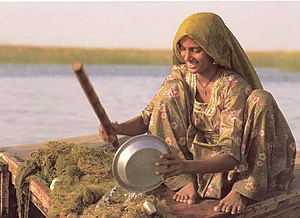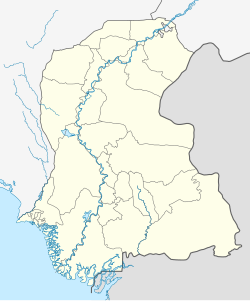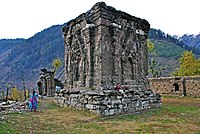Tando Allahyar
Tando Allahyar
| |
|---|---|
| Coordinates: 25°27′42″N 68°43′00″E / 25.46167°N 68.71667°E | |
| Country | |
| Province | |
| Division | Hyderabad |
| District | Tando Allahyar District |
| Established | 1709 |
| Elevation | 21 m (69 ft) |
| Population | |
• Total | 421,923 |
| Time zone | UTC+05:00 (PKT) |
| • Summer (DST) | DST is not observed |
| ZIP Code | |
| NWD (area) code | 02231 |
| ISO 3166 code | PK-SD |
Tando Allahyar (Sindhi: ٽنڊوالهيار, Urdu: ٹنڈو الہ یار) is a city and capital of Tando Allahyar District of Hyderabad Division located in Sindh, Pakistan. As of 2023 Pakistani census, Tando Allahyar Taluka had a population of 421,923.
History
[edit]Tando Allahyar was founded during the rule of Talpur, of the Mir clan. When Bachal Yousfani was mayor, inns and guest houses were built as well as colonies for residents and jobs were created.
Watayo Faqir's shrine
[edit]The shrine of the sindhi oracle and that man was presented thinks his own wisdom Sufi poet Watayo Faqir lies at Kuba Shareef near Rashidabad.
1709 fort construction
[edit]Tando Allahyar was founded in 1709 when Talpur constructed a mud and clay fort about 3 kilometres (1.9 miles) from the present day Tando Allahyar town center. The fort was built to provide security for the Mir and the people of the area. It also functioned as a trading post. As the township developed around the fort, it was known as "Allahyar Jo Tando" (Allahyar's Town). The fort is now called "Kacho Qilo". Some walls decorated at the time of the Mir remain.
British rule
[edit]In 1906, during the British Raj, a railway station was established. It reflected the town's growing importance as a centre of agriculture and trade. The name of the town changed from "Allahyar Jo Tando" to "Tando Allahyar". The British Raj took the fort for its official use.
Local Zamindars
[edit]Tando Allahyar is well known for agriculture and there are many famous sindhi tribes and clans know for owning thousands of acres of lands like the bozdar clan, yousfanis, bachanis, talpurs, jatois, jokhios and many others
Canal
[edit]
In 1933, a canal was constructed. It further increased Tando Allahyar's importance in agriculture and trade.
Independence
[edit]Prior to 1947, the majority of inhabitants of Tando Allahyar were Hindu. The temple of Baba Ramdevji Rama-Pir was a symbol of Hindu–Muslim unity and peaceful co-existence. After independence of Pakistan, many Hindu followers left. Nevertheless, the temple, located in the town centre, remains a popular destination for Hindu pilgrims.
The predominantly Muslim population supported Muslim League and Pakistan Movement. After the independence of Pakistan in 1947, the minority Hindus and Sikhs migrated to India while the Muslim refugees from India settled in the Tando Allahyar District.
Demographics
[edit]Languages
According to 2023 Pakistani census Tando Allahyar Taluka had a population 421,923 consists of males 213,985 and females 207,921. whereas 226,554 people living in urban areas while 195,369 living in rural areas.
At the time of the 2023 census, 312,541 of the population spoke Sindhi, 62,129 Urdu, 18,299 Punjabi, 5,337 Balochi, 5,765 Hindko 3,541 Saraiki, 5,044 Pashto, 3,038 Mewati, 883 Brahui, 177 Kashmiri, 1 Kohistani, 5,195 others as their first language.
Temple
[edit]The Rama Pir Mandir is a temple of Ramdev Pir in Tando Allahyar. It is the second largest pilgrimage site for the Hindus in Pakistan. Every year in Bhadrapada month of Hindu calendar, here the three days Mela arranged by Ramapir Seva Mandali.[clarification needed][2]
Location
[edit]Tando Allahyar lies 25 miles (40 km) northeast of Hyderabad, on the road between Hyderabad and Mirpurkhas. Tando Allahyar is a railway hub for the Sindh region. Early in the nineteenth century, members of the Bozdar family, a community from the Suleiman Mountains, founded the settlements of Khan Muhammad Bozdar (a nearby village of 52 houses), Massu Bozdar, and Dhangano Bozdar.
| Nearby large cities | Distance | |
|---|---|---|
| km | mi | |
| Hyderabad | 42 | 26 |
| Mirpurkhas | 35 | 22 |
| Karachi | 210 | 130 |
| Larkana | 330 | 210 |
| Sukkur | 360 | 220 |
| Pano Aqil | 400 | 250 |
Climate
[edit]Tando Allahyar is hot throughout the year. Nights often have cool breezes throughout the year.
| Climate data for Tando Allahyar | |||||||||||||
|---|---|---|---|---|---|---|---|---|---|---|---|---|---|
| Month | Jan | Feb | Mar | Apr | May | Jun | Jul | Aug | Sep | Oct | Nov | Dec | Year |
| Mean daily maximum °F (°C) | 77 (25) |
79 (26) |
84 (29) |
90 (32) |
111 (44) |
111 (44) |
91 (33) |
88 (31) |
88 (31) |
91 (33) |
88 (31) |
81 (27) |
90 (32) |
| Mean daily minimum °F (°C) | 55 (13) |
57 (14) |
66 (19) |
73 (23) |
79 (26) |
82 (28) |
81 (27) |
79 (26) |
77 (25) |
72 (22) |
64 (18) |
59 (15) |
70 (21) |
| Source: [citation needed] | |||||||||||||
Agriculture
[edit]Tando Allahyar is one of Pakistan's richest agricultural regions. Cash crops like sugarcane, wheat, onion and cotton are cultivated. Mangoes and bananas are also grown. There are sugar mills and some cotton ginning factories.
Mohsin Rasheed Memon Mango Farm on Mir Wah road 3 km from the city centre is a major mango farm. It has Sindhri, dashari, langra, Anwer Ratol, Siroli and Patasha variety.
Religion
[edit]Tando Allahyar's population is predominantly Shia and Sunni Islam. There is also a small Hindu community that exists in the city that mainly engages in business and in rural areas Hindu communities engage in agriculture. There are a few shrines in the city in different areas like Bukera Sharif also there is a very old madrasa in the city with the name of Darul Uloom once called "Saniye Darul Uloom".
Culture
[edit]Tando Allahyar has a rich traditional Sindhi culture. Women may wear a Shalwar Kameez but often wear the traditional dress, the gharara or "parro". Traditionally, many bangles are worn on the arms. Men wear a Shalwar Kameez distinguished by broader bottoms and a traditional Sindhi-style cap. The youth may appear in western styles.
Languages
[edit]Sindhi, Siraiki and Urdu, are the main languages spoken. Other languages including Rajisthani Qaimkhani Khanzada, dhatki, Marwari, Balochi Punjabi and Brahui as well some Dravidian languages.[citation needed]
Architecture
[edit]Tando Allahyar is a bustling town with mango tree lined streets. Old buildings are topped by chimney-like air cooling devices that catch the breeze.
Education
[edit]Rates of literacy are greater in the urban than the rural areas of Tando Allahyar.[citation needed]
Tando Allahyar is a marginalised, lower-income area, with state involvement limited to constructing school buildings and providing teachers. Teachers receive little training and have tended to follow an old-fashioned, authoritarian model of teaching; Zahid Shahab Ahmed noted in 2017 that some teachers had expressed unfamiliarity with the concept of participatory classes where students were encouraged to develop independent critical-thinking ability. Education in Tando Allahyar is generally in Urdu due to its widespread familiarity among students.[3]
External links
[edit]References
[edit]- ^ Cite error: The named reference
2023censuswas invoked but never defined (see the help page). - ^ "Hindu's converge at Ramapir Mela near Karachi seeking divine help for their security - The Times of India". The Times of India. Retrieved 2015-09-18.
- ^ Ahmed, Zahid Shahab (March 2017). Peace Education in Pakistan. United States Institute of Peace. Retrieved 6 August 2020.



